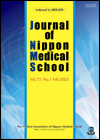Volume 79, Issue 4
Displaying 1-14 of 14 articles from this issue
- |<
- <
- 1
- >
- >|
Photogravure
-
2012 Volume 79 Issue 4 Pages 246-247
Published: 2012
Released on J-STAGE: August 29, 2012
Download PDF (359K)
Review
-
2012 Volume 79 Issue 4 Pages 248-254
Published: 2012
Released on J-STAGE: August 29, 2012
Download PDF (252K)
Originals
-
2012 Volume 79 Issue 4 Pages 255-258
Published: 2012
Released on J-STAGE: August 29, 2012
Download PDF (59K) -
2012 Volume 79 Issue 4 Pages 259-266
Published: 2012
Released on J-STAGE: August 29, 2012
Download PDF (389K) -
2012 Volume 79 Issue 4 Pages 267-273
Published: 2012
Released on J-STAGE: August 29, 2012
Download PDF (118K)
Report on Experiments and Clinical Cases
-
2012 Volume 79 Issue 4 Pages 274-279
Published: 2012
Released on J-STAGE: August 29, 2012
Download PDF (553K) -
2012 Volume 79 Issue 4 Pages 280-283
Published: 2012
Released on J-STAGE: August 29, 2012
Download PDF (114K)
Case Reports
-
2012 Volume 79 Issue 4 Pages 284-285
Published: 2012
Released on J-STAGE: August 29, 2012
Download PDF (144K) -
2012 Volume 79 Issue 4 Pages 286-290
Published: 2012
Released on J-STAGE: August 29, 2012
Download PDF (563K) -
Congenital Dermoid Cyst at the Anterior Fontanelle: Neuroimaging before and after Fontanelle Closure2012 Volume 79 Issue 4 Pages 291-295
Published: 2012
Released on J-STAGE: August 29, 2012
Download PDF (443K) -
2012 Volume 79 Issue 4 Pages 296-300
Published: 2012
Released on J-STAGE: August 29, 2012
Download PDF (448K) -
2012 Volume 79 Issue 4 Pages 301-306
Published: 2012
Released on J-STAGE: August 29, 2012
Download PDF (208K) -
2012 Volume 79 Issue 4 Pages 307-311
Published: 2012
Released on J-STAGE: August 29, 2012
Download PDF (418K)
Short Communication
-
2012 Volume 79 Issue 4 Pages 312-315
Published: 2012
Released on J-STAGE: August 29, 2012
Download PDF (147K)
- |<
- <
- 1
- >
- >|
